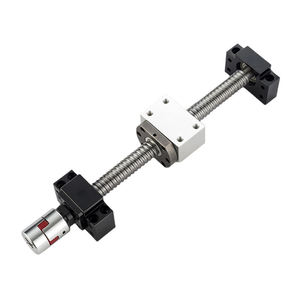(1842 products available)








































































































































































































A lead screw is a type of screw that translates rotary motion into linear motion. When the rotating screw moves a nut, it generates linear motion. A lead screw can also be considered a linear actuator. The following types of lead screws exist:
The specifications of a 16mm lead screw imply various applications in different industries. Some of the specifications and details are as follows:
Maintaining a lead screw is crucial for its performance and longevity. Perform the following maintenance tasks at regular intervals:
Lead screws play a vital role in a variety of industries. Here are some of their common applications.
3D Printers
Lead screws are commonly used in height-moving parts of the 3D printer, such as the Z-axis. They provide the necessary vertical motion to the printer's platform or nozzle. As a result, ensuring precise positioning and stable printing.
Cartesian Robots
Cartesian robots frequently utilize lead screws as their mechanism of motion. The screws convert the rotational motion of their motors, thereby enabling the robot to move along its axes. This ultimately ensures accuracy and repeatability in its positioning.
Fitness Equipment
Some fitness equipment applications, such as treadmills and indoor bikes, may incorporate a lead screw to enable resistance adjustment or seat/parameter customization. Bikes, for example, may use a screw as a seat adjustment mechanism. The durability and smooth motion of a lead screw make it an ideal choice for such applications.
Linear Actuator
Lead screws are commonly used in conjunction with nuts to form linear actuators. Such actuators serve as a motion-transferring mechanism, hence converting rotary motion into linear motion. They find numerous applications in different industries. For instance, in OEM machinery design and robotics.
Medical Devices
Many medical instruments utilize lead screws, such as MRI machines, X-ray equipment, and CT scanners. Through correct positioning of patients or equipment components, they facilitate precise movement and equipment refinement. This enhances the machine's diagnostic capabilities.
Aerospace
The aerospace industry relies on lead screws to produce lightweight, space-efficient, and high-performance mechanisms. They are durable, easy to maintain, and provide smooth motion. Lead screws are commonly used in satellite dishes, telescopes, and walkways, among other applications.
Automotive
Lead screws are widely used in the automotive sector for example in adjusting seats, steering wheels, or pedals, among other parameters. They facilitate position changes in various automotive applications. Rollers are used with other mechanical elements to form the transmission mechanism.
When choosing lead screw assemblies for specific applications, certain factors should be considered to ensure optimal performance and compatibility. Among the factors to consider is the diameter and length of the lead screw. A well-known fact is that the screw's length and diameter will affect its load-bearing capacity and torque generation. Determine the specific application requirements in terms of dimensions before choosing the lead screw with the appropriate length and diameter.
Another way to ensure the right choice of lead screw is by considering the load capacity and torque requirements. Lead screws are designed to carry certain loads, so it is important to match the application's load capacity with the rated load capacity of the screw. Additionally, torque generation is influenced by the screw's diameter and the system's friction. As such, it is important to calculate the required torque for the application and choose a lead screw that can provide the necessary torque.
Check the material and surface treatment of the lead screw and nut. The materials used, as well as, the surface treatments apply to the lead screw and nut can have a serious impact on their durability, corrosion resistance, and overall performance. Choose a lead screw and nut combo that has the right material and surface treatment for the intended use environment in order to achieve optimum performance and longevity.
Also, consider the screw's design, as it can affect efficiency, noise level, and backlash. For example, square threads are more efficient, while trapezoidal threads are more whispering and easier to manage. Choose the lead screw thread design that is right for the project requirements by considering these factors. Lastly, when selecting the lead screw, one must ensure that the nut used with it is also properly selected. The nut must be compatible with the lead screw thread form and pitch, and it should also have the right material and lubrication for optimal performance and smooth operation.
Q1: Can a lead screw assembly be repaired after wear and tear?
A1: In many cases, the lead screw can be repaired, especially if the wear and tear are not extensive. The nut may need replacement, but if it is not damaged, it may be refurbished. However, it is best to consult an expert to see if the parts can be repaired or if they need to be replaced.
Q2: What is the difference between a lead screw and a leads crew with a thrust bearing?
A2: A lead screw uses rotational movement to create linear motion, whereas a lead screw with a thrust bearing can bear weight better due to the bearing.
Q3: How is a lead screw different from a ball screw?
A3: Ball screws are similar in that they also convert rotational motion to linear motion, but the mechanism is different. In a ball screw, as the name describes, balls help facilitate movement, reducing friction and resistance. Lead screws generally have more friction resistance than ball screws and are used in low-load applications where high precision is not required.
Q4: What type of lubrication is used for lead screws?
A4: Oil-based lubricants like grease are used for lead screws because they can carry a heavy load, and viscosity is required to maintain functional movement.